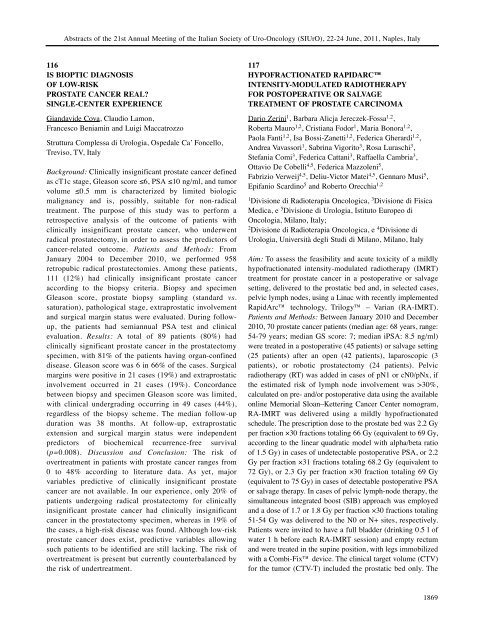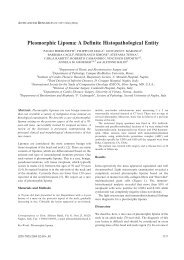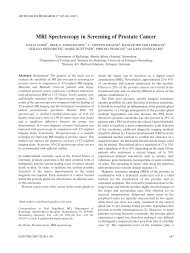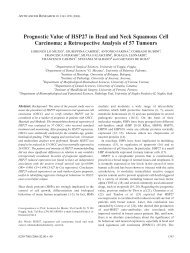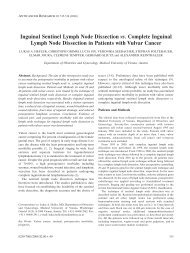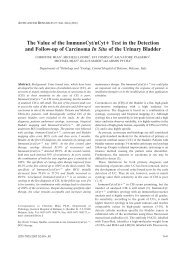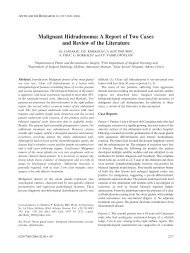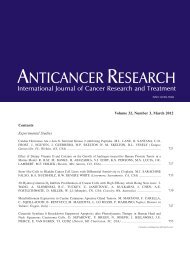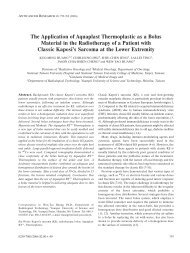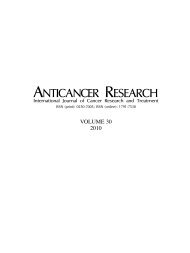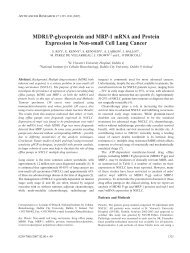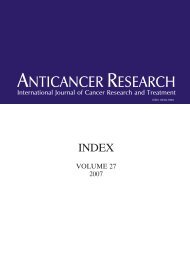ABSTRACTS OF THE 21st ANNUAL MEETING OF THE ITALIAN ...
ABSTRACTS OF THE 21st ANNUAL MEETING OF THE ITALIAN ...
ABSTRACTS OF THE 21st ANNUAL MEETING OF THE ITALIAN ...
You also want an ePaper? Increase the reach of your titles
YUMPU automatically turns print PDFs into web optimized ePapers that Google loves.
Abstracts of the <strong>21st</strong> Annual Meeting of the Italian Society of Uro-Oncology (SIUrO), 22-24 June, 2011, Naples, Italy<br />
116<br />
IS BIOPTIC DIAGNOSIS<br />
<strong>OF</strong> LOW-RISK<br />
PROSTATE CANCER REAL?<br />
SINGLE-CENTER EXPERIENCE<br />
Giandavide Cova, Claudio Lamon,<br />
Francesco Beniamin and Luigi Maccatrozzo<br />
Struttura Complessa di Urologia, Ospedale Ca’ Foncello,<br />
Treviso, TV, Italy<br />
Background: Clinically insignificant prostate cancer defined<br />
as cT1c stage, Gleason score ≤6, PSA ≤10 ng/ml, and tumor<br />
volume ≤0.5 mm is characterized by limited biologic<br />
malignancy and is, possibly, suitable for non-radical<br />
treatment. The purpose of this study was to perform a<br />
retrospective analysis of the outcome of patients with<br />
clinically insignificant prostate cancer, who underwent<br />
radical prostatectomy, in order to assess the predictors of<br />
cancer-related outcome. Patients and Methods: From<br />
January 2004 to December 2010, we performed 958<br />
retropubic radical prostatectomies. Among these patients,<br />
111 (12%) had clinically insignificant prostate cancer<br />
according to the biopsy criteria. Biopsy and specimen<br />
Gleason score, prostate biopsy sampling (standard vs.<br />
saturation), pathological stage, extraprostatic involvement<br />
and surgical margin status were evaluated. During followup,<br />
the patients had semiannual PSA test and clinical<br />
evaluation. Results: A total of 89 patients (80%) had<br />
clinically significant prostate cancer in the prostatectomy<br />
specimen, with 81% of the patients having organ-confined<br />
disease. Gleason score was 6 in 66% of the cases. Surgical<br />
margins were positive in 21 cases (19%) and extraprostatic<br />
involvement occurred in 21 cases (19%). Concordance<br />
between biopsy and specimen Gleason score was limited,<br />
with clinical undergrading occurring in 49 cases (44%),<br />
regardless of the biopsy scheme. The median follow-up<br />
duration was 38 months. At follow-up, extraprostatic<br />
extension and surgical margin status were independent<br />
predictors of biochemical recurrence-free survival<br />
(p=0.008). Discussion and Conclusion: The risk of<br />
overtreatment in patients with prostate cancer ranges from<br />
0 to 48% according to literature data. As yet, major<br />
variables predictive of clinically insignificant prostate<br />
cancer are not available. In our experience, only 20% of<br />
patients undergoing radical prostatectomy for clinically<br />
insignificant prostate cancer had clinically insignificant<br />
cancer in the prostatectomy specimen, whereas in 19% of<br />
the cases, a high-risk disease was found. Although low-risk<br />
prostate cancer does exist, predictive variables allowing<br />
such patients to be identified are still lacking. The risk of<br />
overtreatment is present but currently counterbalanced by<br />
the risk of undertreatment.<br />
117<br />
HYP<strong>OF</strong>RACTIONATED RAPIDARC<br />
INTENSITY-MODULATED RADIO<strong>THE</strong>RAPY<br />
FOR POSTOPERATIVE OR SALVAGE<br />
TREATMENT <strong>OF</strong> PROSTATE CARCINOMA<br />
Dario Zerini1 , Barbara Alicja Jereczek-Fossa1,2 ,<br />
Roberta Mauro1,2 , Cristiana Fodor1 , Maria Bonora1,2 ,<br />
Paola Fanti1,2 , Isa Bossi-Zanetti1,2 , Federica Gherardi1,2 ,<br />
Andrea Vavassori1 , Sabrina Vigorito3 , Rosa Luraschi3 ,<br />
Stefania Comi3 , Federica Cattani3 , Raffaella Cambria3 ,<br />
Ottavio De Cobelli4,5 , Federica Mazzoleni5 ,<br />
Fabrizio Verweij4,5 , Deliu-Victor Matei4,5 , Gennaro Musi5 ,<br />
Epifanio Scardino5 and Roberto Orecchia1,2 1Divisione di Radioterapia Oncologica, 3Divisione di Fisica<br />
Medica, e 5Divisione di Urologia, Istituto Europeo di<br />
Oncologia, Milano, Italy;<br />
2Divisione di Radioterapia Oncologica, e 4Divisione di<br />
Urologia, Università degli Studi di Milano, Milano, Italy<br />
Aim: To assess the feasibility and acute toxicity of a mildly<br />
hypofractionated intensity-modulated radiotherapy (IMRT)<br />
treatment for prostate cancer in a postoperative or salvage<br />
setting, delivered to the prostatic bed and, in selected cases,<br />
pelvic lymph nodes, using a Linac with recently implemented<br />
RapidArc technology, Trilogy – Varian (RA-IMRT).<br />
Patients and Methods: Between January 2010 and December<br />
2010, 70 prostate cancer patients (median age: 68 years, range:<br />
54-79 years; median GS score: 7; median iPSA: 8.5 ng/ml)<br />
were treated in a postoperative (45 patients) or salvage setting<br />
(25 patients) after an open (42 patients), laparoscopic (3<br />
patients), or robotic prostatectomy (24 patients). Pelvic<br />
radiotherapy (RT) was added in cases of pN1 or cN0/pNx, if<br />
the estimated risk of lymph node involvement was >30%,<br />
calculated on pre- and/or postoperative data using the available<br />
online Memorial Sloan–Kettering Cancer Center nomogram,<br />
RA-IMRT was delivered using a mildly hypofractionated<br />
schedule. The prescription dose to the prostate bed was 2.2 Gy<br />
per fraction ×30 fractions totaling 66 Gy (equivalent to 69 Gy,<br />
according to the linear quadratic model with alpha/beta ratio<br />
of 1.5 Gy) in cases of undetectable postoperative PSA, or 2.2<br />
Gy per fraction ×31 fractions totaling 68.2 Gy (equivalent to<br />
72 Gy), or 2.3 Gy per fraction ×30 fraction totaling 69 Gy<br />
(equivalent to 75 Gy) in cases of detectable postoperative PSA<br />
or salvage therapy. In cases of pelvic lymph-node therapy, the<br />
simultaneous integrated boost (SIB) approach was employed<br />
and a dose of 1.7 or 1.8 Gy per fraction ×30 fractions totaling<br />
51-54 Gy was delivered to the N0 or N+ sites, respectively.<br />
Patients were invited to have a full bladder (drinking 0.5 l of<br />
water 1 h before each RA-IMRT session) and empty rectum<br />
and were treated in the supine position, with legs immobilized<br />
with a Combi-Fix device. The clinical target volume (CTV)<br />
for the tumor (CTV-T) included the prostatic bed only. The<br />
1869


